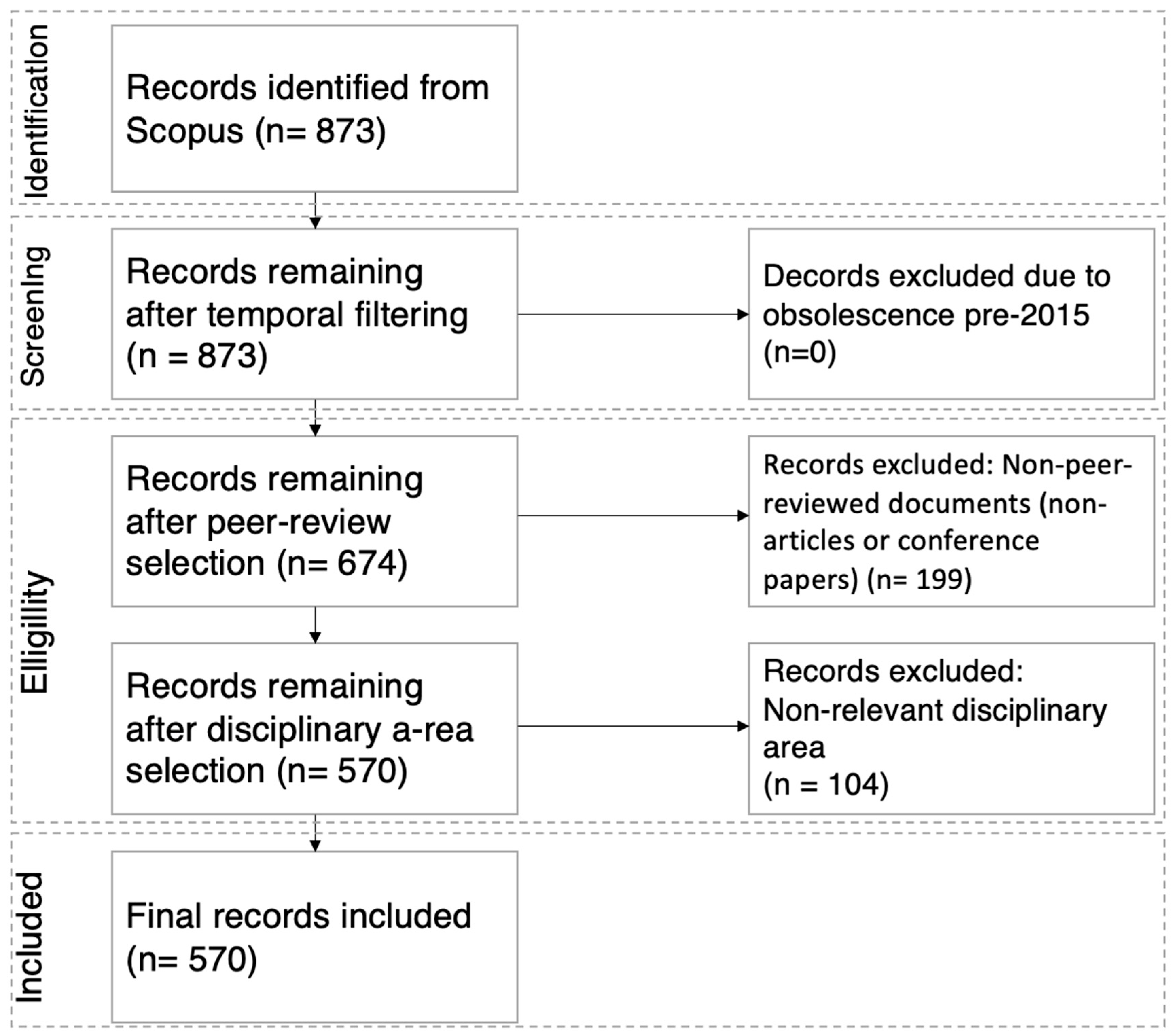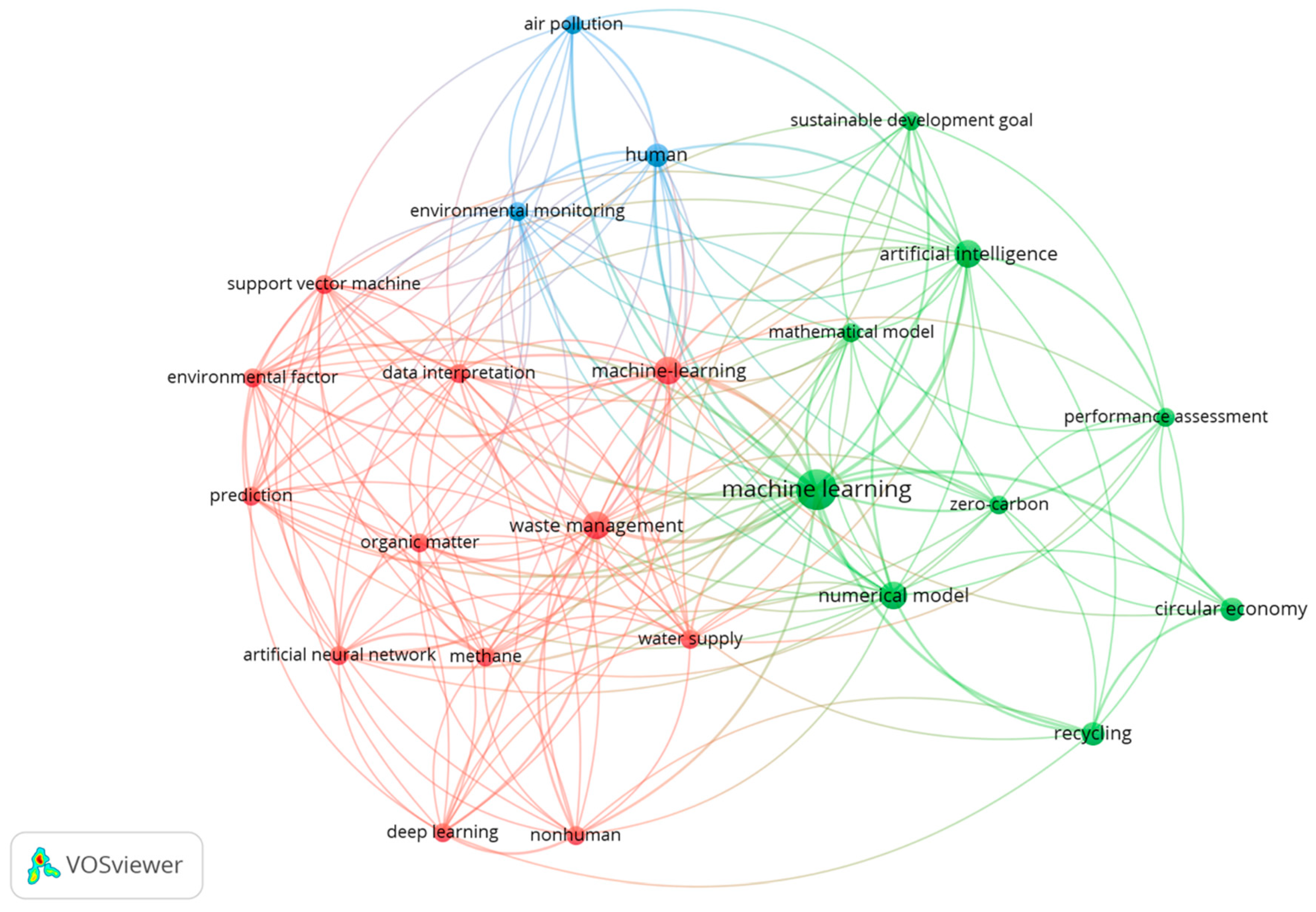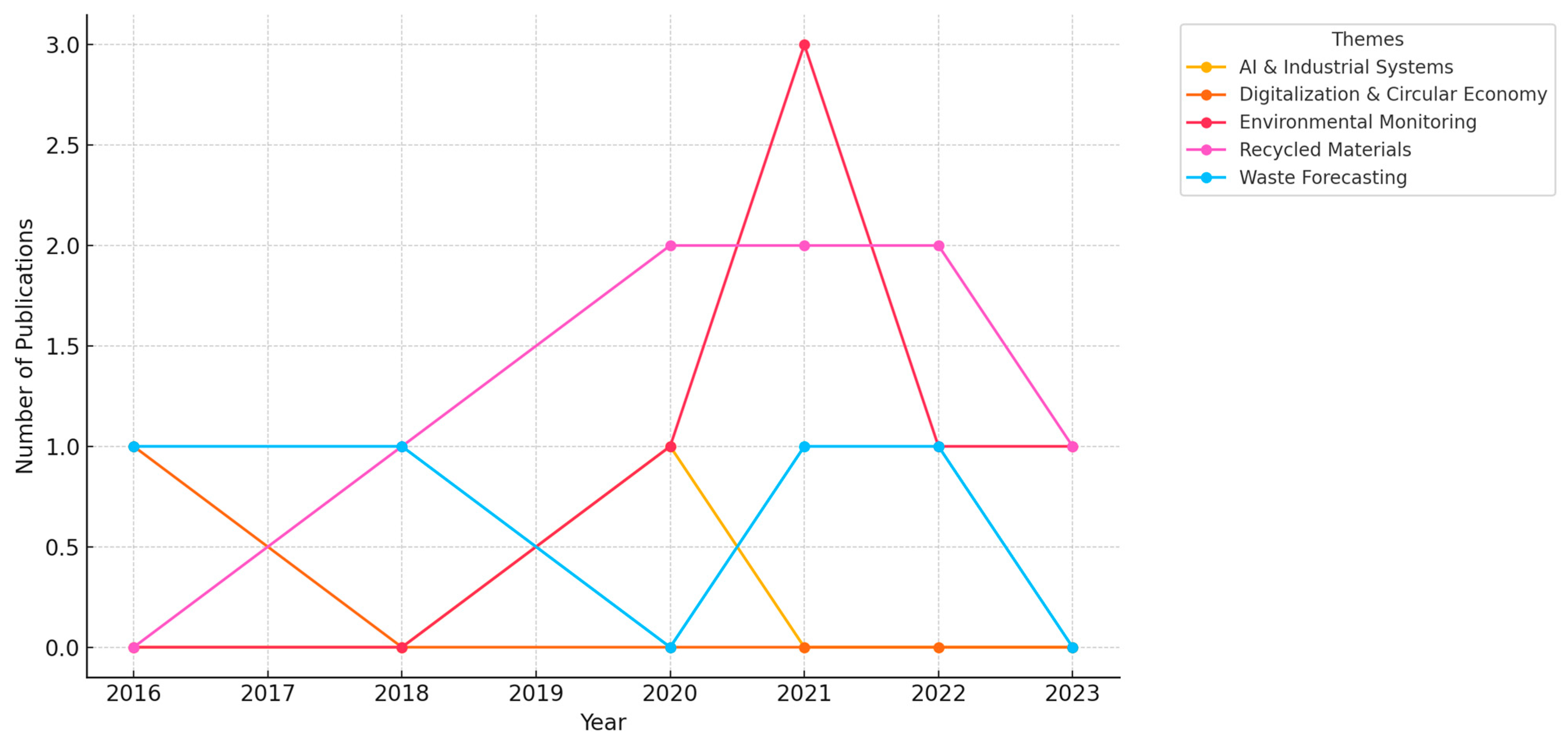3.1. Results of Bibliometric Analysis
The bibliometric analysis performed through VOSviewer produced the network visualization presented in
Figure 3.
The VOSviewer mapping organizes interconnected keywords into three distinct thematic clusters, each represented by a different color for visual clarity. These clusters represent distinct yet interconnected areas of research in the application of artificial intelligence and digital technologies to sustainable waste management.
The red cluster, located on the left and central part of the map, is strongly focused on data-driven methodologies and environmental variables. This group includes keywords such as machine learning, support vector machine, deep learning, prediction, data interpretation, and artificial neural network, indicating a clear emphasis on computational tools used to analyze and model complex waste-related phenomena. Other keywords like methane, organic matter, and environmental factors suggest a research focus on the chemical and environmental dimensions of waste treatment, particularly in contexts such as landfill emissions and organic waste decomposition.
On the other hand, the green cluster, positioned on the right side of the map, highlights research related to optimization, sustainability, and the circular economy. Key terms such as artificial intelligence, digital twin, circular economy, recycling, zero carbon, and sustainable development goals reflect a growing emphasis on integrating advanced technologies into broader sustainability frameworks. This cluster captures the role of AI and digital simulations in performance assessment, process optimization, and supporting the transition to carbon-neutral waste management strategies.
A third blue cluster, positioned toward the upper part of the map, is more concentrated around human–environment interactions. It includes keywords such as air pollution, human, and environmental monitoring, pointing to research that connects waste management with public health concerns and environmental quality. The presence of water supply within the shared areas of the clusters further suggests an interdisciplinary interest in how waste systems intersect with other resource infrastructures.
Visually, the red cluster appears dense and positioned toward the center-left of the map, indicating a high level of internal connectivity among keywords related to analytical models and algorithmic processing of waste-related data. In contrast, the green cluster is more dispersed and located on the right side of the visualization, illustrating a broader systemic perspective encompassing sustainability goals and strategic innovation. Meanwhile, the blue cluster, though smaller, adds depth by emphasizing social and environmental monitoring dimensions.
Table 3 summarizes the top 10 most frequently co-occurring keywords identified through this bibliometric analysis, reinforcing the conceptual structure illustrated in the visualization. Leading the ranking is prediction (TLS = 128), a term closely aligned with the red cluster, underscoring the prominence of forecasting techniques in waste estimation and emissions modeling. Keywords such as artificial intelligence (TLS = 119) and artificial neural network (TLS = 106) also reflect the dominance of AI-based methods across the literature. These terms, alongside machine learning and environmental management, form the analytical core of the red cluster’s emphasis on computational modeling.
Notably, recycling (TLS = 94) and waste management (TLS = 90) bridge the red and green clusters, demonstrating the integration of data-driven tools with sustainability-oriented practices. Lower-ranked but conceptually important terms like adaptation strategies and adaptation strategy (TLS = 69 and 68, respectively) suggest a growing interest in flexible, resilience-focused waste management frameworks, potentially intersecting with the blue cluster’s socio-environmental themes.
The interconnections among the clusters suggest that sustainable waste management is increasingly addressed through a multi-layered approach, combining AI-based modeling, real-time environmental monitoring, and strategic planning aligned with sustainability goals. These overlaps reveal the field’s interdisciplinary nature and underscore the relevance of digital innovation in addressing the complexity of circular and low-emission waste systems.
3.2. Scientific Journals and Geographic Distribution of Research Output
Table 4 displays the top 10 most productive journals in the field of AI-based waste management and environmental applications, ranked by total number of publications.
Waste Management and the
Journal of Cleaner Production lead the list with 25 publications each, reflecting their central role in disseminating research on predictive modeling, recycling technologies, and smart sustainability practices.
Other notable journals include Construction and Building Materials (18 publications) and Science of the Total Environment (17 publications), which emphasize interdisciplinary approaches to construction waste, environmental quality, and technological innovation. Sustainability (Switzerland) and the Journal of Environmental Management also feature prominently, underlining the growing relevance of AI in both theoretical and applied environmental research.
This ranking highlights the increasing visibility and cross-sectoral interest in machine learning and data-driven solutions for sustainable development. For scholars and practitioners, these journals serve as key reference points for emerging trends, case studies, and methodological advancements in smart waste and resource management.
Table 5 presents a ranking of countries based on their contributions to the literature on AI and digital technologies in waste management, measured by total number of publications (TNP), total citations (TNC), and total link strength (TLS). The data reveals a geographically diverse research landscape, with a strong presence from both developed and emerging economies.
Australia leads the ranking with 39 publications and a total link strength of 23, indicating not only a high volume of output but also robust international collaboration within the field. This is followed by Saudi Arabia (25 publications, TLS = 14) and Iran (22 publications, TLS = 18), both of which demonstrate active engagement in AI-driven environmental research, with Iran showing particularly high citation impact (139 citations).
The United States ranks fourth in terms of output (16 publications), though with relatively low citation impact (52 publications), suggesting either newer entries into the field or less visibility of published work. Bangladesh (14 publications) and Denmark (8 publications) reflect rising participation from countries with growing interest in sustainability and waste-related technological innovation.
Interestingly, Hungary stands out for its high citation-to-publication ratio (90 citations from only three documents), indicating that its contributions, though limited in quantity, are of significant academic influence. Similarly, countries like the United Arab Emirates and the Netherlands, despite low publication counts, demonstrate meaningful participation, as measured by citation and collaboration metrics (TLS of six and four, respectively).
Overall, the geographical spread highlighted in
Table 4 confirms the global relevance of AI in sustainable waste management and the importance of fostering international research networks. The variation in total link strength (TLS) also reflects differing levels of collaborative integration across countries, underscoring opportunities to enhance knowledge exchange and cross-border partnerships in this rapidly evolving field.
3.3. Mapping Key Research Streams Through the Most Cited Contributions
The bibliographic analysis subsequently focused on the 20 most-cited articles [
15,
16,
18] addressing the application of AI and Digital Twins (DT) in sustainable waste management. These publications, presented in
Table 6, represent foundational scientific contributions in the field. They provide a comprehensive overview of evolving research trends, influential authors and journals, and thematic priorities addressed in recent years [
16,
18].
The decision to analyze the most-cited rather than the most recent papers was driven by the intention to avoid imposing two consecutive temporal constraints on the bibliometric analysis—the first stemming from the predefined search period in Scopus and the second which would have resulted from selecting only the most recent publications. Thus, the analysis focuses on contributions that have had the greatest scientific impact, capturing well-established theoretical and methodological foundations in the field [
15,
17,
18].
The analysis of the 20 most-cited articles highlights the emergence of a multidimensional and strongly interdisciplinary research landscape. Intelligent technologies are redefining how waste management challenges are addressed, with applications ranging from waste generation forecasting and recycled material design to environmental simulation and industrial optimization within the circular economy framework.
The first key research area involves the use of AI for waste generation prediction and management. Nguyen et al., 2021 [
35] developed machine learning models to accurately estimate urban solid waste generation in residential areas, emphasizing the integration of socio-economic data. Similarly, Abbasi and El Hanandeh, 2016 [
45] adopted a combination of Adaptive Neuro-Fuzzy Inference System (ANFIS) and k-Nearest Neighbors (k-NN) to produce reliable monthly forecasts, demonstrating the applicability of such approaches to support urban decision-making. At the regional level, Kannangara et al., 2018 [
46] employed multi-layer neural networks to model waste generation and recovery in Canada, while Vu et al., 2022 [
47] showcased how Recurrent Neural Networks (RNN) and Long Short-Term Memory (LSTM), combined with cross-validation techniques, significantly improve waste disposal prediction accuracy.
A second major research area focuses on the use of AI and ML for optimizing recycled materials, particularly in the construction sector. Zhang et al., 2021 [
36] and Feng et al., 2022 [
39] developed predictive models to determine the mechanical and thermo-mechanical properties of recycled concrete, including rubber-modified variations. Similarly, Tran et al., 2022 [
40] and Gholampour et al., 2020 [
42] applied advanced techniques such as Multivariate Adaptive Regression Splines (MARS), M5 Model Tree (M5Tree), and Least Squares Support Vector Regression (LSSVR) to evaluate compressive strength. At the same time, Peng and Unluer, 2023 [
37] and Liu et al., 2021 [
38] used hybrid models based on Artificial Neural Networks (ANN) and nature-inspired optimization algorithms to simulate aspects such as carbonation and environmental durability of concrete, proposing data-driven solutions for sustainable building.
Digitalization for circular economy purposes emerged as another transversal research theme. Reuter, 2016 [
43] proposed an integrated model to digitalize metallurgical processes and material life cycles, combining technologies such as DT and metallurgical Internet of Things (m-IoT). Likewise, Zhang et al., 2020 [
50] illustrated the effectiveness of multi-objective and hybrid intelligence models in guiding the design of high-performance recycled concrete, contributing to more efficient and sustainable resource management.
The environmental management of electronic waste and heavy metal contamination also emerged as a significant area. Chen et al., 2022 [
49] and Yang et al., 2021 [
52] applied random forest models and geospatial analysis to identify hotspots and risk sources, while Yaseen, 2021 [
48], in a comprehensive review, explored the potential of ML models to simulate contamination in soil and water resources, highlighting new perspectives for environmental monitoring. In the geotechnical domain, Jalal et al., 2021 [
53] developed AI models such as ANN, ANFIS, and Gene Expression Programming (GEP) to predict the swell strength of expansive soils, supporting sustainable infrastructure design.
The role of deep learning in environmental monitoring has also been explored in the literature. Fan et al., 2023 [
44] analyzed the use of AI to achieve Sustainable Development Goals (SDGs), highlighting applications ranging from waste management to environmental health. Furthermore, Chen et al., 2020 [
54] proposed a Convolutional Neural Network (CNN)-based architecture for intelligent detection of water pollution using Near-Infrared (NIR) analysis, offering a promising solution for sustainable agriculture and water quality management.
Finally, growing attention has been paid to the integration of AI, DT, and industrial systems. Fisher et al., 2020 [
51] presented a framework that combines data-driven methodologies with the Cross-Industry Standard Process for Data Mining (CRISP-DM) to develop predictive models in production processes, with a particular focus on waste valorization and decision support in industrial contexts.
To complement the thematic categorization, a temporal analysis of the most-cited contributions from 2016 to 2023 was conducted to capture the dynamic evolution of research in this field. This dimension addresses the reviewer’s concern by highlighting how scholarly attention has shifted over time in response to technological advances and policy priorities.
The line graph below (
Figure 4) illustrates the emergence and evolution of five major research themes: waste forecasting, recycled materials, environmental monitoring, digitalization and circular economy, and AI and industrial systems. The data reveal three distinct phases: an initial focus on forecasting and isolated applications of AI (2016–2018), followed by an expansion into recycled materials and optimization (2019–2021), and finally, a surge in environmental and industrial integration with Digital Twins and deep learning (2021–2023).
This trend indicates a growing systemic perspective, where AI and DT are not only used for prediction or optimization but are increasingly embedded within environmental governance, industrial valorization processes, and sustainability frameworks.
In support of this visualization,
Table 7 summarizes the temporal distribution of the most-cited articles, organized by theme. This format emphasizes the continuity and expansion of specific research areas and provides direct references to key contributions over time.
This integrated temporal and thematic analysis contributes to a more nuanced understanding of how research on AI and Digital Twins for sustainable waste management has matured and diversified.
3.4. Summary of Thematic and Conceptual Clusters
Overall, the analyzed literature highlights a growing focus on the application of digital and intelligent solutions to address environmental challenges in waste management. AI is emerging not only as a predictive tool but also as a strategic enabler for the digitalization of material flows, real-time environmental monitoring, optimization of production cycles, and sustainable design. Emerging technological trajectories indicate a shift towards predictive and integrated models capable of reducing environmental impacts, valorizing waste as a resource, and supporting the transition to a circular economy.
This study is characterized by its integrated methodological approach, which combines bibliometric analysis with qualitative thematic review. This synergy enabled a comprehensive understanding of current research trajectories, mapping areas of high scientific intensity and identifying interdisciplinary connections between predictive modeling tools, digital simulation, and sustainability strategies. In particular, the emphasis on the role of AI, DT, and hybrid ML models offers an original contribution aimed at promoting a systemic and data-driven perspective on waste management.
Table 8 summarizes the results of the analysis in a structured format, associating each identified macro-theme with key authors and relevant keywords selected exclusively from those emerging in the bibliometric map (frequency ≥ 3). This organization highlights the main research lines, the most conceptually dense areas, and the semantic relationships among the thematic clusters. The combined approach, integrating conceptual clusters and keyword co-occurrence analysis, has provided a coherent and structured representation of the current scientific landscape, confirming the multidimensional and interdisciplinary nature of digital applications in sustainable waste management.
To complement the thematic clusters and enrich methodological understanding,
Table 9 provides a concise overview of the main AI and ML techniques adopted in each research area. For each macro-theme, the table specifies the computational models, the underlying logic (e.g., regression, classification, and simulation), and the corresponding functional purposes (e.g., prediction, optimization, and monitoring). This summary helps clarify how digital methods concretely support scientific and operational advances in sustainable waste management.
This methodological breakdown reinforces the multidimensional nature of the field, showing how specific AI and ML techniques are strategically deployed to address diverse operational and environmental challenges. The integration of regression, simulation, and classification approaches across application domains highlights a growing convergence toward intelligent, adaptive, and predictive waste management systems.












